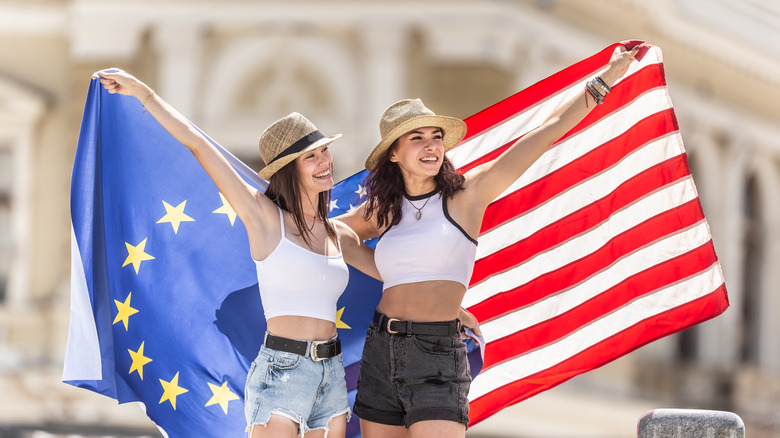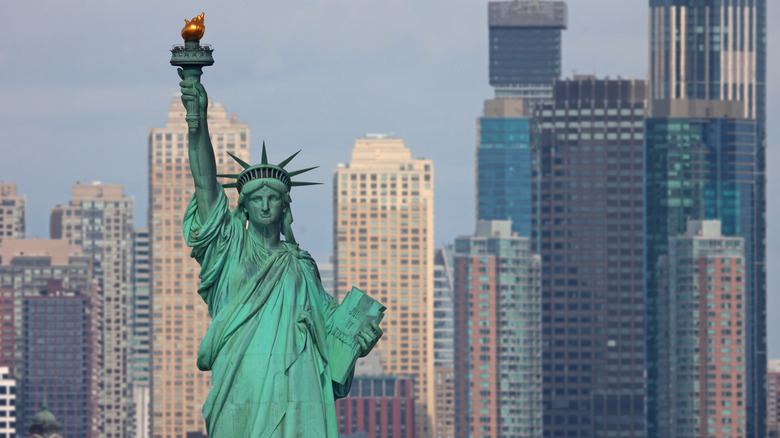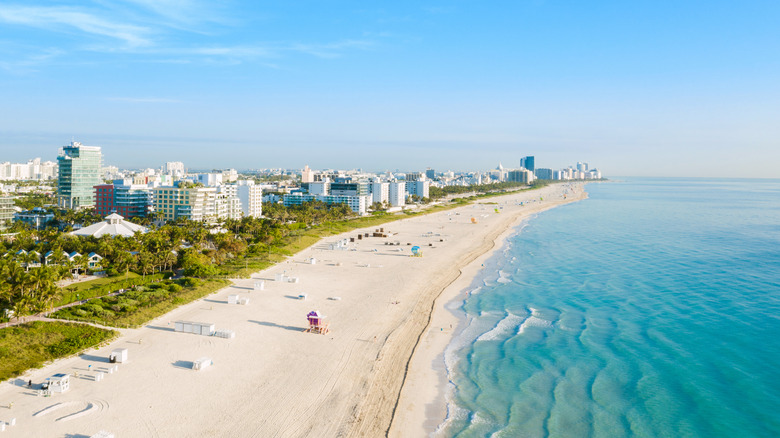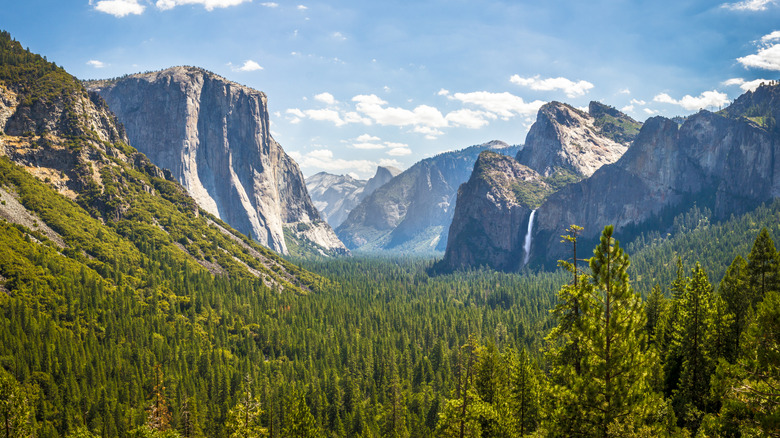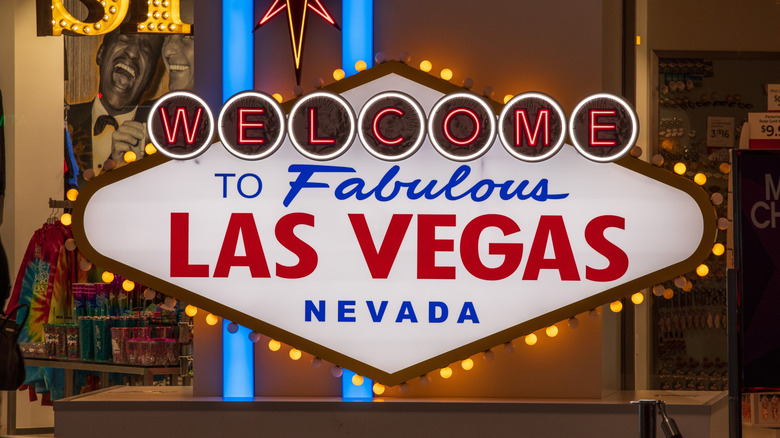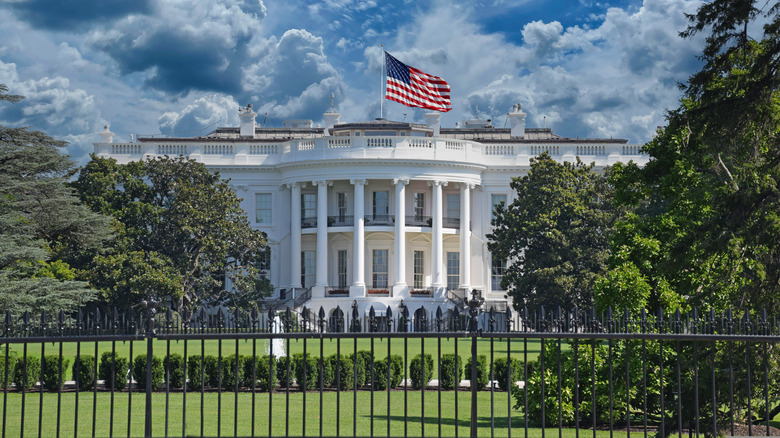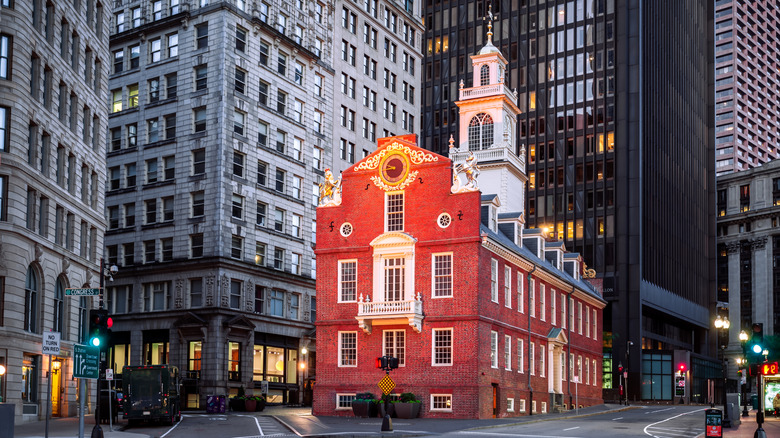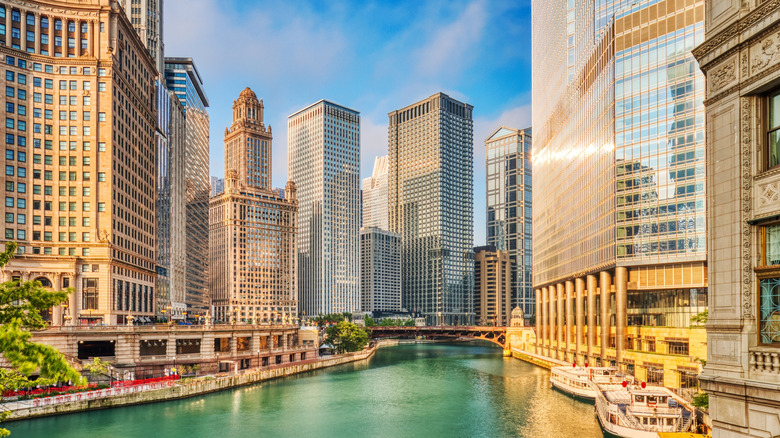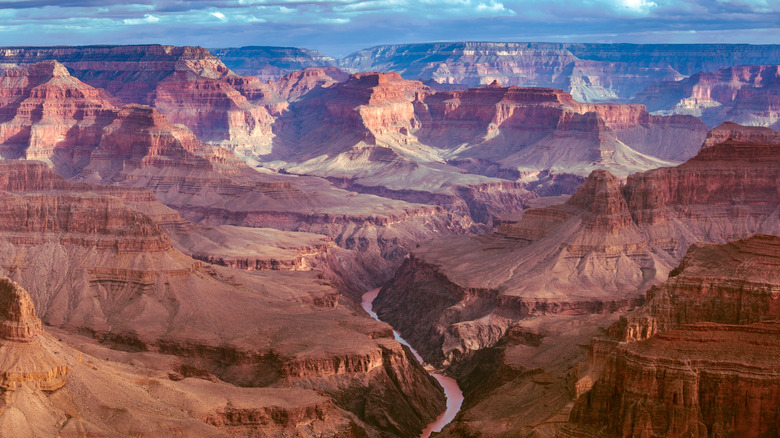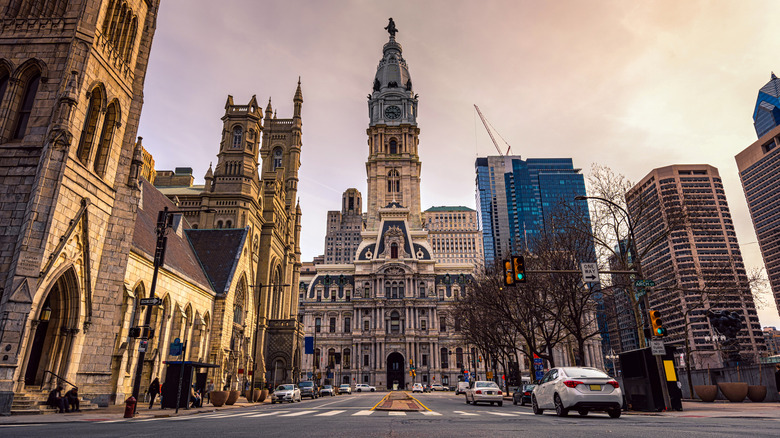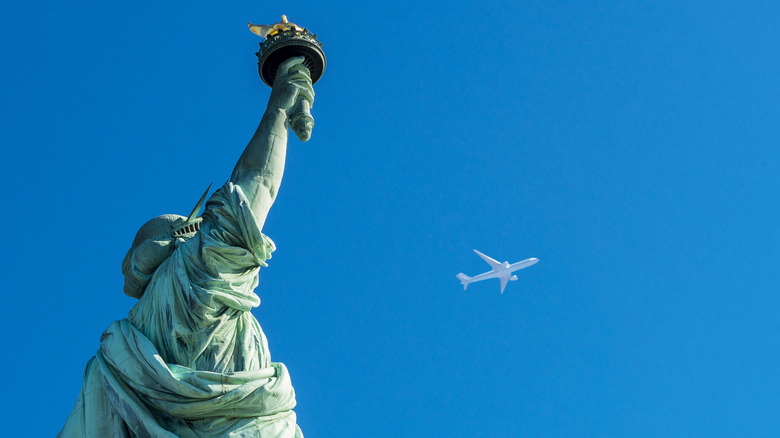The Most Popular Vacation Destinations In America Among Europeans, According To Research
America: Land of the free, home of the brave ... and cowboys, Big Macs, Hollywood, apple pie, and all the rest. Every European knows the clichés, fueled by movies, magazines, TV shows, and literature, but they can't get enough. Of course, they have plenty of their own to shout about, but according to the International Trade Administration, millions made their way across the Atlantic Ocean for some firsthand American adventures in 2024. Most came from the United Kingdom, with plenty of Germans and the French following suit. Spanish and Italians made up the majority of the rest, but Dutch, Belgians, Scandinavians, and, let's be honest, every other nationality that's legally permitted also made it. However, for clarity, we have focused the numbers in this article on the top five mentioned.
But where do all those Europeans go, and what do they think? Well, if you read forums like that on Rick Steves' Europe, you'll see many think of the U.S. as a large, diverse country that offers a very different experience from home. National parks and the country's dramatic landscapes are a major draw, and cities like New York, San Francisco, and Washington, D.C., are all viewed as iconic destinations. History is also of interest to those folks from across the pond, with the Revolutionary and Civil Wars capturing imaginations and driving exploration. So, let's take a closer look at which destinations in the USA Europeans like to visit the most.
New York
New York State received over 3 million visitors from Europe's big five in 2024, and New York City would undoubtedly be the premier destination for the majority. But what is it with Europeans' obsession with the Big Apple? Sure, there are world-famous attractions like Times Square, Central Park, and the Statue of Liberty, but Europeans have more than just some of America's worst tourist traps on their radar.
Most will have been exposed to American culture via TV when growing up, but these movies and shows may have led to stereotypical beliefs about the city and the U.S. in general. American politeness, for example, isn't something that is highlighted much through the media, but one Latvian traveler on the Travelher blog claimed, "People in NYC are the most polite people I have ever met." She also highlighted her appreciation for the city's skyscrapers and commented on the uniquely different skyline.
Exploring the food is also a huge draw, as (apparently) portions are not very big across the Atlantic. In fact, some Europeans seem to think everything is bigger in New York. One Redditor responded to a question asking if the city was what they expected by listing numerous points, including, "Roads, cars, [and] portions are ridiculously big." Whether that's a compliment is up for debate, but the city's outdoor dining culture definitely shines, while the "can-do" attitude of New Yorkers is something that often leaves a lasting impression. However, not everything does. The homeless situation in the city perplexes many Europeans, while trash on sidewalks and, according to StreetsBlogNYC, a somewhat dangerous cycling infrastructure, are things that may take the shine off a visit.
Florida
The British seem to love Florida. Of the 4 million or so who visited the U.S. in 2024, around a quarter went to the Sunshine State, with Miami and Orlando the preferred destinations. Walt Disney World and Universal Orlando, on top of the Kennedy Space Center and one of America's best science museums, make it easy to work out what they would be doing in Orlando. It's a magical family vacation destination, and the Brits prefer it over Miami. But the Germans and French love Miami, as do the Spanish and Italians. So what's the big attraction?
The obvious answer is beach life. One Californian resident from Poland, who likes to visit Miami, explains on her blog that the warm, clear, turquoise waters of the city's beaches are ideal for relaxing, especially when you get away from the busy Ocean Drive area. However, those Europeans aren't just beach bums. Miami's Latin culture is a strong draw, too. One Redditor commented that they "loved the diversity of the city, [including] the strong Cuban influence and the tropical vibe." The same person also mentioned the city's Art Deco district in South Beach, which they said "looked amazing." This trendy beach paradise captivates with its sun-kissed geometric architecture, tropical motifs, and distinctive pastel colors. It's a unique visual experience for Europeans, and they find it exotic and highly photogenic.
However, many come to Miami with preconceived notions of the city that stem from the media, and it sometimes fails to live up to the hype. So much so that travelers do sometimes leave negative opinions, including one Reddit user who said, "It seems like your typical Spanish beach city in the Mediterranean, just with way more skyscrapers. Like a bigger Benidorm," which isn't really a compliment.
California
Europeans love that California packs an abundance of diversity into a single state. Not all countries across the Atlantic can say they have such variety, as there are sun-soaked beaches, towering forests, sprawling deserts, and snow-capped peaks all jammed into one slender slice. Around 1.75 million visitors arrived from Europe in 2024. And while many would have headed to the regular stops of Los Angeles and San Francisco, the state's natural wonders are popular, too.
On the blogging platform Medium, one European expat who has lived in the Golden State for two decades listed Big Sur, Yosemite National Park, the Sierra Nevada mountains, Joshua Tree, and the vast Mojave Desert as among his favorites. On a similar note, one Redditor responded to the question, "What do Europeans think of California?" by saying, "I loved California. Pretty much every minute of it. The nature was stunning." The commenter listed Big Sur, Sequoia National Park, and Lake Tahoe among their favorites.
With all that Californian nature and a climate that actively encourages an outdoor lifestyle, Europeans naturally enjoy outdoor activities when visiting the state. Surfing, hiking, mountain biking, rock climbing, and Napa Valley wine tasting are all easily accessible, while a multicultural mix of diverse food, festivals, and communities makes the state perpetually fascinating. The immigrant-rich population creates various social experiences for Europeans, who sometimes find it easier to meet people there compared to back home. However, it's not all sunshine and rainbows. San Francisco's chilly, windy weather and high costs surprise many visitors, while LA's notorious traffic frustrates. And, like NYC, the stark homelessness crisis shocks visitors who struggle to reconcile visible suffering with the wealth of the area.
Nevada
Nevada received around 940,000 arrivals from Europe in 2024, and the vast majority of them were unquestionably heading straight to Las Vegas. There's little doubt that movies and TV shows have glamorized Sin City, but how do Europeans actually enjoy the Entertainment Capital of the World? Well, if you scour around forums like Reddit and Tripadvisor, you'll find differing opinions. Some find the city good for a fun weekend, while others don't consider it worth crossing the Atlantic for as a standalone destination. And despite the popularity, Europeans often find Las Vegas lacking in cultural depth, unlike the historic charm offered by Boston and Philadelphia. In fact, some find it downright tacky and too commercialized.
Despite the mixed reviews, Vegas is an undeniable spectacle. The dazzling lights, themed mega-resorts, and the iconic Strip deliver a sensory overload quite unlike anywhere else. And it's the city's nonstop energy that draws European visitors in. Many even come just to see the hotels, while world-class entertainment, high-profile soccer matches, and the annual Formula 1 Grand Prix offer big appeal to Euros. However, they also love the eccentricity, and getting married in a drive-through chapel or eating at a breakfast table with a built-in poker machine is peak Vegas absurdity you simply can't find in Europe.
Washington, D.C.
There's something unmistakably French about Washington, D.C., which is probably down to the fact that Parisian architect Pierre Charles L'Enfant designed much of the place. Walk around and you'll see reminders of the City of Light, including the city's wide boulevards, elegant buildings, and traffic circles dotted with fountains and statues. You'll also find Parisian charm in the city's cuisine and art, and it's these aspects of America's capital that make European visitors feel right at home.
But of the 500,000 arrivals who visited the "Paris of America" from Europe last year, French numbers surprisingly trailed behind the Brits and Germans. Well, it's their loss, because D.C. packs in trendy neighborhoods, fantastic food, iconic landmarks, free world-class museums, and nonstop cultural events. Architecture buffs love the Neoclassical, Victorian, Romanesque Revival, and Beaux-Arts styles, with buildings like the Old Post Office and Library of Congress being real standouts. A commenter on the urbanism-focused forum Skyscraper City even said, "Washington is the one city on the globe that Europeans in the 19th century would have built if they were going to build a city from scratch."
Among the must-sees in a city packed with free museums for history buffs are the Natural History Museum, the Air and Space Museum, and the fascinating International Spy Museum. However, arguably the real draw for Europeans is seeing the government buildings and historic monuments, including the Capitol, the Supreme Court, the Washington Monument, the Lincoln Memorial, and, of course, the White House. Tours around the latter might be tough to snag, but it doesn't stop Europeans from attempting anyway, especially after flying all that way.
Massachusetts
Europeans might have a healthy interest in American history, but their knowledge can be sketchy. A visit to Boston helps correct a lot of their misconceptions. The city's story began back in 1630 when waves of European immigrants began construction on the city we know today. The historic Freedom Trail in downtown Boston guides visitors through 16 major landmarks, including Boston Common and Bunker Hill. It is also home to the Old State House, the city's oldest public building, where the Declaration of Independence was read in 1776.
The Boston Tea Party obviously occurred here, but what you may not know is that the vast majority of the 425,000 or so European arrivals to Massachusetts in 2024 were in fact British. Playful comments on Reddit like "I'm sure the Brits just love the harbor" and "Come on, lads, let's have some tea" in reference to the event certainly don't put them off. One English woman writing for the EF education platform is very positive about Boston and claims that the famous act of tea-tipping defiance lives on in Americans through their love for coffee. In fact, the city's downtown café scene is in full swing and is another reason why Europeans feel so at home there.
Those visitors also love the city's layout and architecture. The Commonwealth Avenue Mall runs from the Public Garden to the Fens in a Paris-inspired layout, and a certain Winston Churchill once called it "the grandest boulevard in North America." European-inspired architecture is evident at the Beaux-Arts-style Boston Public Library and the Isabella Stewart Gardner Museum, which was modeled on Venetian Renaissance palaces. But the excitement doesn't end there. With whale watching on offer half the year, Harvard University tours, and lip-smacking lobster rolls, there's more than enough to keep visitors happy.
Illinois
Illinois received just over 400,000 visitors from Europe in 2024. Chicago would have undoubtedly been the destination for most of them, and with celebrated architecture, renowned museums, and a fantastic food scene, it's easy to understand why. Kate, a German blogger who relocated to the Windy City, wrote about the things that she loved most about Chicago on her professional coaching platform Share The Love. Among her highlights were arts and culture, especially the overwhelming number of theaters and the artistic works showcased everywhere. She also loved the distinctive mix of architectural styles from different eras and the deliberate attempts to make up for brutal winters through neighborhood festivals, live music, and food events in the summer.
As to what Europeans primarily know about the Windy City, one Redditor left a comment on a 2018 post saying, "I went there once. The Navy Pier was nice, as was really all of the waterfront. The architecture was amazing, and I think I heard Chicago was famous for this." Indeed, the heart of Chicago is a lively waterfront neighborhood and a hub of architectural innovation, one shaped by movements such as Beaux-Arts, Art Deco, and Modernism, and standouts include Willis Tower (once the world's tallest) and Aqua Tower, a landmark of 21st-century architecture. River cruises are one of the most popular ways to explore the city's structures, and guided tours are available with in-depth stories behind the iconic skyscrapers and architectural styles from an open-air deck.
Arizona
Europeans arrived in Arizona by the planeload in 2024, and while the state does have many other attractions, it's difficult to see anything other than the Grand Canyon being their primary destination. This geological wonder needs no introduction to Americans, and to the rest of the planet, it's a top bucket-list destination. In fact, one Quora post asking foreigners about their feelings upon seeing it for the first time is overwhelmingly positive. "The Grand Canyon is a treasure of the planet. It makes no difference where you're from. And it doesn't matter whether it's your first time or 100th time seeing it" is a quote from the forum page that generally sums up the feelings of everyone. Almost all commenters describe the canyon as being far more immense and stunning than they anticipated.
Many visitors were also surprised by the color and shadow, with one of them adding to the Quora discussion that "it is a photographer's dream," and another mentioning, "It changes with light and shadow in front of your eyes." So, for Europeans, the U.S. isn't just about architectural grandeur and glitz and glamor; on that side of the Atlantic, they are very well aware of the natural wonders the country also has to offer. However, visitors from Europe, or anywhere else for that matter, should pay attention to the site's unwanted status as the national park with the highest number of deaths in America. That said, with visitor numbers equal to that of a small country, some accidents should be expected. Just keep a lookout for the many warning signs.
Texas
Gun culture and large gas-guzzling vehicles are things that Europeans frown upon when assessing the Lone Star State. However, that doesn't stop them from coming, with Texas receiving just over 500,000 visitors from across the Atlantic in 2024. Cowboy hats, ranches, BBQ, and country music are the iconic aspects they like, but they also have love for the big cities with their sprawling suburbs, vast rural areas, and long open roads.
The diverse landscapes across the state are also a hit, from the deserts in the west to the swamps in the east and all the plains, hills, and humid coastline in between. Friendly locals and the warm climate also please visitors, as does the food. In fact, chowing down on Texas BBQ and Tex-Mex is a major draw. One Texan who ran food tours in the state mentioned on Quora that while many (particularly the French) were not impressed, "Germans and Eastern Europeans almost universally loved barbecue," while one Brit mentioned that "Austin is a bit different to most U.S. cities I have been to for culture, food, and music."
In fact, Austin is often cited as an excellent place to enjoy nightlife and live music, with one Redditor commenting tongue-in-cheek on a subreddit called AskEurope that "I've heard jokes about Austin having more music venues than it has people." All in all, Texas resonates positively with Europeans, and San Antonio's Riverwalk and the Alamo are top destinations, while Fredericksburg is a hit for German heritage and wine tasting. Houston stands out for the Johnson Space Center, while the Dallas-Fort Worth area offers a range of museums and JFK history that are also big attractions.
Pennsylvania
Around 250,000 European visitors arrived in Pennsylvania in 2024. Europeans enjoy the entire state with its mix of big cities, small towns, and scenic countryside. With a food culture set up by Italian, German, and Pennsylvania Dutch traditions, they feel right at home, too. However, the state is especially known for its deep American history, particularly the Revolutionary and Civil Wars. Philadelphia is the choice for those with an interest in America's past, with attractions including Independence Hall and the Liberty Bell.
Despite its role in the American story, the City of Brotherly Love is also described as feeling distinctly French. One major landmark that confirms this is the City Hall, a French Second Empire architectural masterpiece. It's the largest municipal building in the U.S., and guided tours through its grand historic rooms are a big hit with foreign visitors. However, Philadelphia doesn't just draw in tourists from Europe; the city also attracts plenty of domestic visitors looking for a Euro-like ambience.
It's not all about the French influence. The Philadelphia Museum resembles a Greek temple, while a certain Philly cheesesteak was conceived by Italians. Elsewhere around the state, Lancaster County appeals for its Amish culture and countryside scenery, while Adams County satisfies history buffs with Gettysburg, as does Montgomery County with Valley Forge.
Methodology
To get approximate European arrival numbers to the USA, we consulted figures from the International Trade Administration. The latest data from 2024 shows total visitor numbers from individual European countries, the percentage breakdown of which regions and cities they visited, plus additional demographic and travel pattern data. We worked out the numbers for individual states from the percentages to provide you with approximate numbers, but we only looked at those from the five most populous countries in Europe (excluding Russia), which are Germany, the U.K., France, Italy, and Spain.
